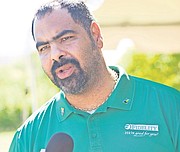• Mid-Year Budget projects $11.4m deficit widening
• And ‘conservative’ $53m rise in full-year revenue
• Capital budget cut $12m; SIE subsidies up $35m
By NEIL HARTNELL
Tribune Business Editor
nhartnell@tribunemedia.net
Bahamians should be “wary” but not alarmed after the Government yesterday revealed a modest $11.4m increase to its forecast 2022-2023 fiscal deficit along with a similar-sized capital spending cut-back.
Fiscal observers said the revised $575.4m deficit, up from the originally planned $564m, was “not material in the grand scheme of things” as the Davis administration unveiled a $76.5m increase in its recurrent or ‘fixed cost’ spending above the estimates produced in last May’s Budget.
Gowon Bowe, Fidelity Bank (Bahamas) chief executive, said he and other private sector chiefs who attended Monday’s Business Round Table meeting with the Prime Minister and key Cabinet members were informed that both revenue and public spending “in certain cases” were outpacing the 2022-2023 Budget projections.
Asserting that the $11.4m deficit increase is “nothing to write home about”, he told Tribune Business that yesterday’s mid-year Budget appeared consistent with the message delivered to the private sector. “They indicated at the briefing that they should be able to come in at the deficit projected,” Mr Bowe said. “They had indicated some of the revenue elements were outpacing projections, but expenditure in certain cases was also outpacing forecasts.”
The Prime Minister, in announcing the supplementary Budget and spending appropriations, said the revisions “would not be possible” without government revenues for the six months to end-December 2022 exceeding forecast targets by $79.4m to come in at $1.257bn. Despite outperforming projections, he added that the Government is now only predicting that revenues will exceed Budget estimates by some $53m.
And, of that $53m increase, some $8m is being generated by the return of “unused” Department of Social Services monies to the Consolidated Fund. “The Department of Social Services identified $8m of unused balances on its accounts at Bank of The Bahamas and Kanoo. These amounts were for previous years, so they had to be transferred to the Consolidated Fund and accounted for as revenue,” Mr Davis explained.
“In keeping with our conservative approach to managing our fiscal affairs we have only increased our revenue projections for the entire fiscal year by $53m, which includes the $8m returned by Bank of The Bahamas and Kanoo. The net increase is $45m, which is only 56 percent of the excess revenue received by the Government.” That 56 percent is a percentage of the $79.4m increase during the first six months of the fiscal year.
However, the Opposition yesterday voiced concern over the widening deficit, and recurrent spending outpacing the growth in revenues. Michael Pintard, its leader, told Tribune Business: “They are confirming what we know already - that the deficit is widening. He [the Prime Minister] should have at least acknowledged the fact that has happened. I didn’t hear any plausible explanation from him as to why that occurred.”
And, speaking to this newspaper before the mid-year Budget, the FNM leader said the Government’s frequent attempts to secure increased revenue suggested all was far from well on the fiscal front. Besides the changed VAT treatment on health insurance claims payouts, and fee increased at agencies such as the Road Traffic Department, he pointed to the administration’s accessing of $232.3m in IMF special drawing rights (SDRs).
“We know the Government is experiencing a cash crunch,” Mr Pintard argued. “It’s clear given the frequency with which they have introduced new fees. That is one clear indication. The fact they have drawn down on the SDRs held by the Central Bank. All of these are red flags absent an explanation as to what motivated these fee increases, the draw down on SDRs, the way they’re putting an additional burden on consumers by VAT treatment of medical claims.
“All this suggests that the Government is under tremendous financial pressure, and rather than have a candid conversation with the public about the fiscal position they find themselves in they continue to put pressure on the pockets of Bahamians.”
However, Mr Davis, who spent much of the mid-year Budget blasting the former Minnis administration for causing the national debt to increase by more than $3bn during COVID-19 and Hurricane Dorian, asserted: “I have a simple message for the Bahamian people. Our policies are working.”
While the increased $76.5m recurrent spending is not material in the context of a $3bn Budget, a deeper dive into the data released by the Ministry of Finance yesterday shows the Government is largely moving around and reallocating funds as needed to address new priorities and challenges as they emerge. This has resulted in a $12.1m cut to capital spending forecasts, with this sum dropping from May’s $371.1m to a new $359m.
The supplementary Budget also reveals that taxpayer subsidies to loss-making state-owned enterprises (SOEs) are set to increase by $35m, or 7.7 percent, compared to the May Budget estimate, reaching just shy of $500m or half a billion dollars at a total $492.24m.
The majority of that increase is an extra $20m allocated to the Water & Sewerage Corporation to help pay bills due to its reverse osmosis suppliers. Another $3m is being provided to the Bahamas Public Parks and Beaches Authority, taking its total subsidy for 2022-2023 to $27m, while the University of The Bahamas is to receive a further $5.2m in taxpayer subventions.
The Airport Authority, too, is to receive an additional $4m to help cover its “operating expenses”, which will bring its subsidy to $12.542m. The increases unveiled in the supplementary Budget represent a reversal of the Minnis administration’s plan to cut SOR subsidies by a collective $100m over three years, and are heading in a different direction from that unveiled by the Government’s recently-published Fiscal Strategy Report.
To enable a $38.278m increase in the Ministry of Education’s capital budget, so as to facilitate school repairs and new construction, cuts have been made elsewhere. The Ministry of Works and Utilities’ capital budget has been slashed by some $20m to $101.399m, with cut backs in areas such as building maintenance, bridge repairs, road repairs, ports and docks, water and airport infrastructure. The $20m cut matches the increased Water & Sewerage subsidy.
The Ministry of Finance’s capital works budget, too, has been lowered by some $18.069m. Small and medium-sized business support has been cut by 50 percent, from $8m to $4m, although financing to aid this sector is contained elsewhere in the Budget. And funds earmarked for Family Island capital development have been reduced by $10m - from $12m to $2m.
Successive administrations have cut capital spending to a minimum as a means to keep annual fiscal deficits in check, but this has left key public infrastructure - roads, docks, bridges, hospitals and schools - that provide a critical platform for economic growth starved of financing for development and upkeep.
Hubert Edwards, the Organisation for Responsible Governance’s (ORG) economic development committee head, told Tribune Business that while the reduction in capital spending compared to the May Budget did not appear “significant” it required monitoring.
“I don’t know that the number you mentioned would be of any great significance to worry about in terms of paring back, but I concur with your suggestion that over the years governments have used capital spending as a means to manage the the deficit,” he agreed.
“The overall concern would be that, in totality, is your capital Budget sufficient to drive things in the economy and be beneficial to long-term growth. Any type of cut backs, you want to be a bit wary. The question of cut backs in this instance doesn’t seem to be significant in the grand scheme of things, but you want to see your capital spending increasing rather than decreasing.”
Another source, familiar with Budget processes, was more alarmed. “The criticism of the Government is that it has always under-spent on capital works,” they said. “These are the things we need to ramp up. Governments have been consistently starving capital expenditure to fund recurrent spending. That’s a road to nowhere. You cannot have economic development if the infrastructure is not up to standard.”
Similarly, Fidelity’s Mr Bowe said of the reduced capital budget: “It should definitely be an area that causes the antennae to go up for the Bahamian people. When you look at current infrastructure, would you consider it to be the most modern? Absolutely not. What we don’t want is a situation of delayed repairs, maintenance and development that costs me in the future.”
He pointed to World Bank and IMF research suggesting that capital spending on infrastructure works in the Latin American and Caribbean region needs to be equivalent to 5 percent of annual gross domestic product (GDP) to drive growth and development. The Bahamas, for 2022-2023, has dropped from 2.8 percent to 2.7 percent, further explaining why the Government is seeking to source private capital and management via public-private partnerships (PPPs).
As for the rise in SOE subsidies, Mr Edwards said: “We don’t want to see that increasing given that SOEs have been at the forefront on the table for reform for a number of years. If we are moving closer to $500m, that’s not a good thing.”






Comments
Flyingfish 1 year, 2 months ago
Any administration that cuts infrastructure funding is foolish, good infrastructure can empower economies.
Commenting has been disabled for this item.